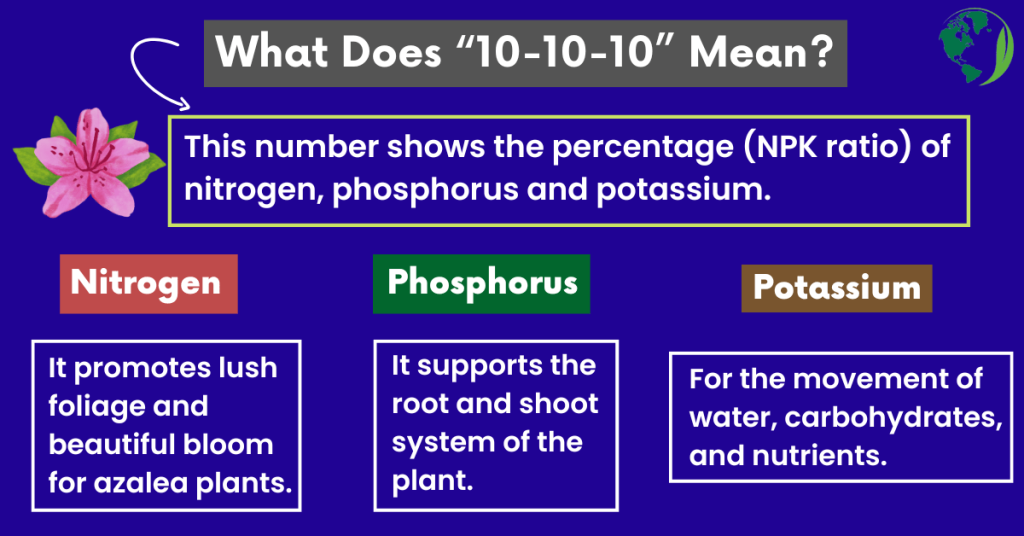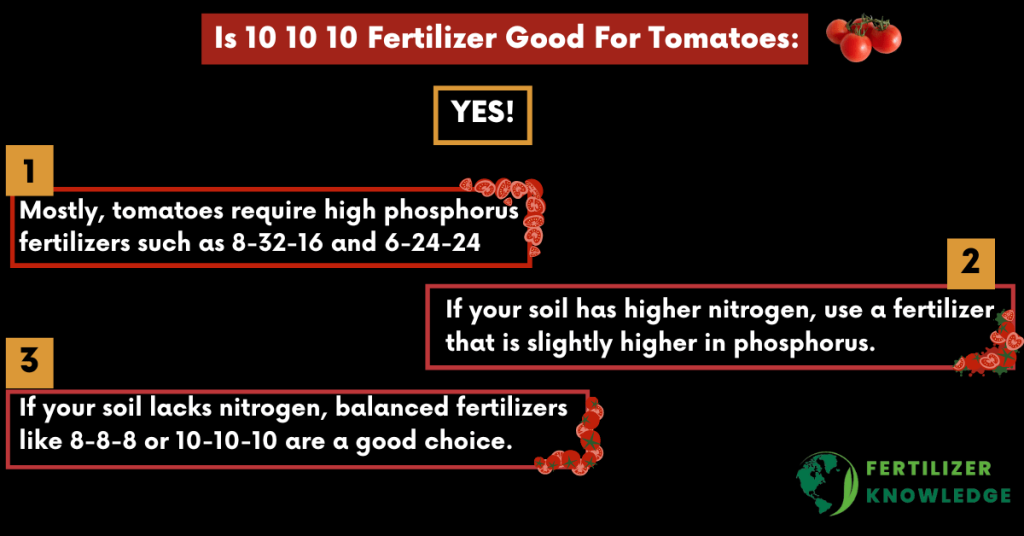Can I use 10 10 10 fertilizer for azaleas? Let’s find out.
Hint: Yes! You can.
But before moving ahead, let me introduce azaleas to you.
Azaleas are flowering small to medium-sized shrubs. They are popular due to their brightly coloured blooms and long-lasting flowers.
The best part?
They require little maintenance and have a range of sizes and shapes.
Now, let me introduce the 10 10 10 fertilizer.
What Does “10-10-10” Mean?
This number shows the N-P-K ratio. In simple words, it shows the percentage of nitrogen (N), phosphorus (P) and potassium (K).
So, the 10-10-10 fertilizer contains:
- Nitrogen: 10%
- Phosphorus: 10%
- Potassium: 10%
Now, I have a question for you. How are these nutrients important for azaleas?
Let’s find out.
Nitrogen:
Nitrogen is the most important nutrient for azaleas. Fertilizer recommendations are based on nitrogen.
It encourages the shrub to grow faster.
This is because it is a source of energy for metabolic processes in plants.
Respiration, photosynthesis, and nitrogen fixation are some examples of metabolic reactions in plants.

Remember that nitrogen is a component of chlorophyll. Chlorophyll is a compound by which plants make sugars through photosynthesis.
Now the question is, why is nitrogen important for flowering plants?
It is used to make amino acids, proteins, nucleic acid, and DNA (deoxyribonucleic acid). Over here, note that plants obtain nitrogen in form of nitrates.
Summary: Nitrogen promotes fruit and seed development. It also encourages lush foliage growth.
Now, let’s talk about phosphorus.
Phosphorus:
It promotes plant blooms.
Here’s why phosphorus is important for azaleas.
You should know that it is a major component of ATP (Adenosine triphosphate). It is a structure that provides energy to the plants.
Some other prominent functions of phosphorus are:
- Energy transfer
- Photosynthesis
- Movement of nutrients
- Transformation of sugar and starch
Here’s something important.
The major function of phosphorus is that it supports the shoot and root systems of plants.
It leads to fruit and flower development as well.
Note that azaleas take up phosphorus in its primary forms. These are called orthophosphates, H2PO4– and HPO42-.
Pretty simple, right?
Summary: It promotes the growth of roots and flowers. It also protects the plant from environmental stress and harsh winters.
Now, let’s talk about potassium.
Potassium:
As I mentioned earlier, there is 10% potassium (K) in the 10 10 10 fertilizer.
It is important for azaleas as it builds up plant cells.
You should know that Potassium allows the movement of nutrients, water, and carbohydrates.
All this makes fruit juicier and sweeter. This also improves the quality of flowers.
It activates the enzymes which make starch, ATP, and proteins.
The question is, how is it done?
This is done by regulating the opening and closing of stomata (cell structure involved in gaseous exchange).
Now, I have a question for you. How does a plant obtain Potassium?
It is taken up in form of Potassium ion (K+).
Pretty simple, isn’t it?
This takes us straight to our next topic.
Can I Use 10 10 10 Fertilizer For Azaleas?
Here’s what you should know.
Overview: Can I Use 10 10 10 Fertilizer For Azaleas? Yes! Nitrogen promotes lush foliage and beautiful bloom for azalea plants. The 10-10-10 fertilizer fulfils the low nutritional requirements. Note that azaleas are not heavy feeders. Therefore, rich soil with plenty of organic matter eliminates the requirement for additional fertilizer.
Let’s talk about all this in detail.

What kind of soil do azaleas like?
This is something that you should know first.
Azaleas prefer (moist) acid soils (pH around 5.5) with plenty of organic content, such as compost.
Remember that azaleas do not grow well in pure sand, heavy clay, and alkaline soils. So, they require well-drained soil.
The table below summarizes this:
| Soil Characteristics | Azalea Soil Requirements |
|---|---|
| Soil pH | Acid soil (pH of 4-6). |
| Soil structure | Soil should have an aerated structure for good drainage. |
| Soil drainage | They need well-draining soil. |
| Composition | Loam soil (with organic matter) is ideal. |
Now back to the topic.
Here are some reasons why the 10 10 10 fertilizer is a good choice for azaleas.
- It is a balanced fertilizer.
As the name suggests, it has an equal amount of macronutrients. In this case, we have 10% nitrogen, phosphorus, and potassium.
Earlier, we discussed the importance of these nutrients for azaleas.
The idea is that this fertilizer will prevent nutrient deficiency. Here are some indications for nutrient deficiencies:
- Nitrogen deficiency: Pale yellowish-green plant with slow growth.
- Phosphorus deficiency: It inhibits (slows down) shoot growth. The leaves may turn dark as well.
- Potassium deficiency: Potassium-deficient plants wilt on dry, sunny days.
In short, balanced fertilizers, such as 10-10-10 and 18-18-18 fertilizers, prevent this.
- It provides nitrogen.
As we discussed earlier, nitrogen is essential for shrubs like azalea bushes.
Moreover, it promotes lush foliage and beautiful bloom for azalea plants.
We have already discussed how nitrogen deficiency impacts the growth of flowering plants. The idea is that the 10 10 10 fertilizer keeps your plant healthy.
- Azaleas have low nutritional requirements compared to other shrubs.
Here’s why this is important.
Azaleas are not heavy feeders. If they are planted in rich soil with plenty of organic matter, they do not need additional fertilizer.
Due to the low nutritional requirements of azaleas, the 10-10-10 fertilizer is a great fit for them.
Along with nitrogen, it provides phosphorus and potassium.
Amazing, isn’t it?
- The application process is simple.
We will take a look at the application process in detail.
For now, note that the application process is as simple as spreading the granules with your hands (or sprayer).
For azaleas, slow-release granules work great.
As the name suggests, they release nutrients over a course of time. Pretty simple, isn’t it?
When and How To Use 10-10-10 Fertilizer?
When:
Recall the NPK ratio.
This shows that there is 10% nitrogen, phosphorus and potassium. Here’s what I mean.
- The idea is that the fertilizer application will depend on the nutrient requirement.
Let me explain.
There is no “perfect” time for fertilizer application for azaleas.
If there is any nutritional deficiency or the plant is growing slowly, you should consider adding a fertilizer.

Note: For optimal growth and blooms, check your azalea type.
- Fertilize in spring (March/April).
You should add the 10 10 10 fertilizer in early spring for azaleas.
Here’s why.
In spring, new growth starts. This means that nutrient uptake begins as the soil temperature increases.
Remember that you should avoid fertilizing after mid-summer. This is because nutrients are not absorbed during the fall or winter.
- Apply the fertilizer in the early evening or late afternoon.
Can you guess why is this important?
The sun’s rays can burn your grass due to the heat of a scorching afternoon.
As a general rule, it is good to water your lawn before and after fertilizer applications.
I highly recommend you read the instructions provided by the manufacturer.
How:
Note that you should be extremely careful during the application process.
This is because over-application can damage your plant.
Important note: Azaleas are vulnerable to leaf scorch due to excess nitrogen.
So here’s the step-by-step guide.
- Conduct a soil test.
As the word suggests, soil testing determines the fertility of the soil. Here’s what I mean.
It typically evaluates pH, organic matter, buffer pH and more.
In this way, you can determine the amount of fertilizer to use. After a soil test, move on to the next step.
- For granular fertilizer:
This is simple. You have to apply the granules to the soil surrounding your azaleas.
Then, cover it with mulch at the start of spring. This will provide nutrients to the soil throughout the growing season.
You can also use a fertilizer spreader. When applying, spread it in a circular manner (away from any exposed roots).
- For the best application rates, follow the instructions on the package carefully.
Before applying the fertilizer, read the instructions on the package. These will vary depending on the brand.
After this, apply the fertilizer around the dripline (the area underneath the foliage) of your plant.
Then, water it thoroughly for 15 minutes after the application. This will ensure that the nutrients reach the root system of the plant.
Is 10 10 10 Fertilizer Good For Tomatoes:
If your soil lacks nitrogen, balanced fertilizers like 8-8-8 or 10-10-10 are a good choice.
Look, growing tomatoes is tricky. But, let me make it simple for you.
If your soil is correctly balanced (or has higher nitrogen), you should use a fertilizer that is slightly higher in phosphorus and lower in nitrogen.
For example, an NPK ratio of 5-10-5 or 5-10-10 is ideal.

As we discussed earlier, over-application can destroy your plant. We also discussed how phosphorus is involved in root growth.
To be precise, the 10% nitrogen, phosphorus and potassium make it suitable for tomatoes.
Simple, right?
Is 10 10 10 Fertilizer Good For Cucumbers?
You can use it for cucumbers. But, there are better options.
This is because cucumbers need moderate nitrogen and high phosphorus and potassium. So, the 10-10-10 NPK ratio is not ideal.
Remember that cucumbers are heavy feeders. This means that they require plenty of nitrogen, phosphorus and potassium.
So, a good general-purpose fertilizer will provide these nutrients in proper proportions.
If we talk about the soil composition, cucumbers need well-drained soil with a neutral pH.
To be precise, fertilizers with moderate nitrogen and high phosphorus and potassium are good for cucumbers.
Is 10-10-10 Fertilizer Good For Lawns?
Yes! It is great for lawns.
We have already discussed the importance of nitrogen for plants. The idea is that it promotes healthy growth and makes your lawn greener.
Moreover, the 10-10-10 fertilizer improves the soil quality as well. To achieve the best results, follow the instructions on the package.
Related: When to Fertilize Lawn in Florida | Step-by-Step
Now, let’s talk about some disadvantages of the triple 10 fertilizer.
The Disadvantages:
- Nitrogen can erode during spring rains.
Remember that this pollutes your ponds and streams. As a result, the fish and invertebrates are harmed.
- It contains dangerous chemicals.
Let me explain.
The chemical in this fertilizer can be harmful to our health. Therefore, protective clothing is recommended before applying the fertilizer.
Remember that inorganic fertilizers may contain a lot of salt. This can build up in your soil and clog the roots of your plant.
- Overfertilization can damage your plants.
As we discussed earlier, excess nitrogen can kill your plant. It can even make your plant vulnerable to diseases.
So, you should be careful when applying the fertilizer.
Wrapping Up:
So, there you have it.
Can I use 10 10 10 fertilizer for azaleas? Yes! You can.
The NPK ratio is ideal for tomatoes and lawns as well.
But, you should be careful when applying this fertilizer. This is because over-fertilizing your plant can cause chemical burns.
If you have any questions, feel free to get in touch. Stay tuned for more.
Related:
Calcium Ammonium Nitrate Fertilizer (CAN) | The Ultimate Guide
What is 30-10-10 Fertilizer Used For?
